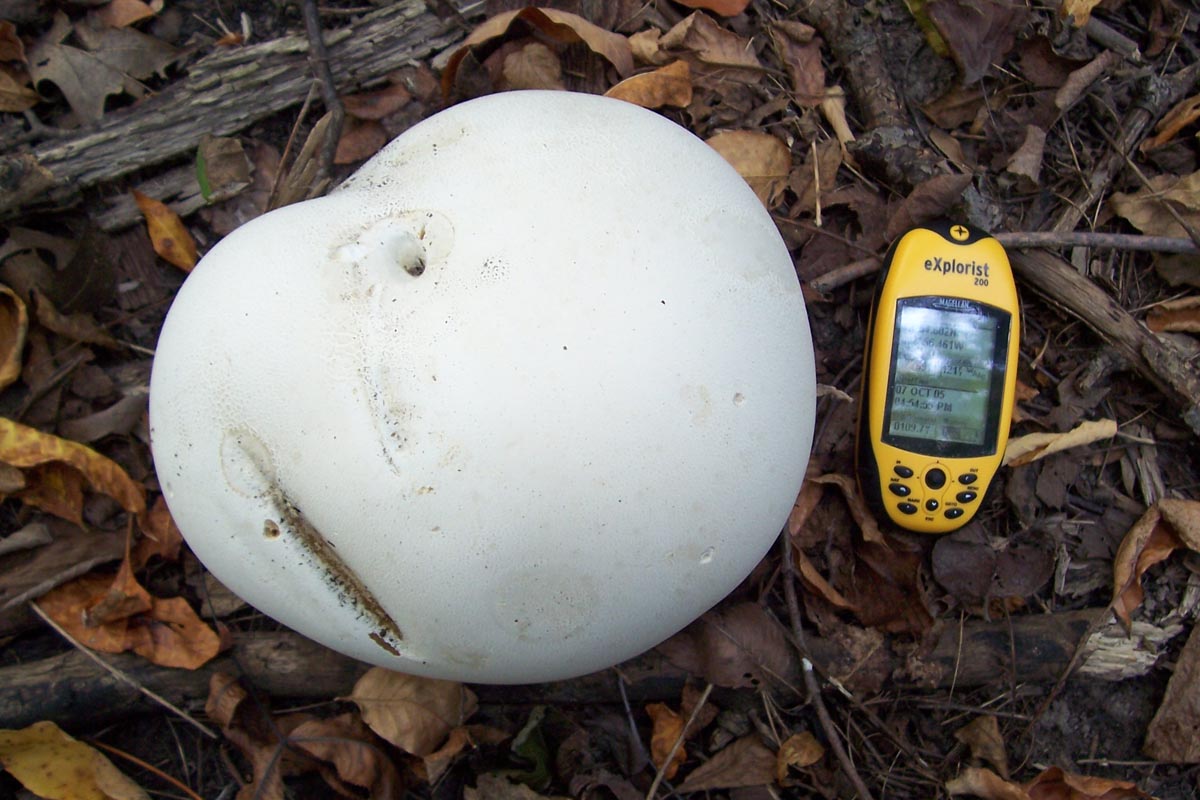- Calvatia gigantea
Taxobox
name = Giant puffball

image_width = 200px
image_caption = Giant puffball with object for scale
regnum = Fungi
divisio =Basidiomycota
classis =Agaricomycetes
ordo =Lycoperdales
familia =Lycoperdaceae
genus = "Calvatia "
species = "C. gigantea"
binomial = "Calvatia gigantea"
binomial_authority = (Batsch ex Pers.) Lloydmycomorphbox
name = Calvatia gigantea
whichGills = NA
capShape = no
hymeniumType= gleba
stipeCharacter= NA
ecologicalType=mycorrhizal
sporePrintColor=brown
howEdible=edible"Calvatia gigantea", commonly known as the Giant puffball, is a
puffball mushroom commonly found in meadows, fields, and deciduous forests worldwide usually in late summer and autumn. It is common throughoutEurope andNorth America .Description
Most giant puffballs grow to be convert|10|to|70|cm|in in diameter, although occasionally some can reach diameters up to convert|150|cm|in and weights of convert|20|kg|lb. The inside of the mature Giant puffballs is greenish brown, whereas the interior of immature puffballs is white. The large white mushrooms are edible when young. To distinguish giant puffballs from other species, they must be cut open; edible puffballs will have a solid white interior. Some similar mushrooms have the white interior (or yellowish) but also have the silhouette of a cap-type mushroom on the interior when cut open. These are young cap-type mushrooms and may be poisonous.
The fruiting body of a puffball mushroom will develop within the period of a few weeks and soon begin to decompose and rot, at which point it is dangerous to eat. Unlike most mushrooms, all the
spore s of the giant puffball are created inside the fruiting body; large specimens can easily contain several trillion spores. Spores are yellowish, smooth, and convert|3|to|5|um|in in size. The dry spores can be used as a coagulant to help stop bleeding.The classification of this species has been revised in recent years, as the formerly recognized class Gasteromycetes, which included all puffballs, has been found to be
polyphyletic . Some authors place the giant puffball and other members of genus "Calvatia " in orderAgaricales . Also, the species has in the past been placed in two other genera, "Lycoperdon" and "Langermannia".Cooking
All members of the true puffball family are considered edible, but be sure to cut the young ones open to make sure there are no gills hidden inside.
Some claim the meat tastes very similar to
tofu or meltedcheese when cooked. To prepare, remove any brown portions and tough skin, which sometimes peels off easily. Do not soak in anything. Puffballs may be sauteed, broiled, or breaded and fried; they do not dehydrate well, but may be cooked and then frozen.Resembles
The deadly
amanita s have a volva or "universal veil" that completely envelops the young mushrooms. Before bursting forth from the volva, they look like little round puffball mushrooms.Fact|date=September 2008Additionally, puffballs resemble the earthball ("Scleroderma citrinum"). The latter are distinguished by a much firmer, elastic fruiting body, and as an interior that becomes dark purplish-black with white reticulation early in development.
=References
External links
* [http://americanmushrooms.com/edibles3.htm AmericanMushrooms.com: The Giant Puffball]
* [http://botit.botany.wisc.edu/toms_fungi/aug98.html The Giant Puffball]
* [http://www.cirrusimage.com/fungi_giant_puffball.htm Giant Puffball Photo and Write up]
* [http://www.wildflowers-and-weeds.com/mushrooms/Lycoperdaceae.htm Lycoperdaceae: The True Puffball Family]
Wikimedia Foundation. 2010.
